Once the tallest structure in the world, the 330-meter-tall Eiffel Tower is probably Europe’s best known landmark and the most famous sight in Paris.
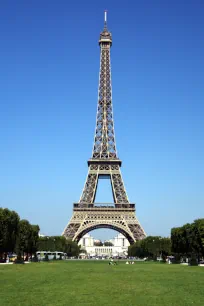
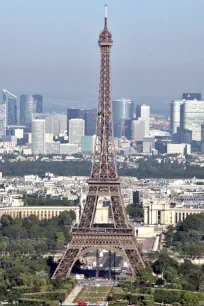
You couldn’t possibly visit Paris without seeing the Eiffel Tower. Even if you do not want to visit this world-famous structure, you will see its top from all over Paris. When it was completed at the end of the nineteenth century, it was twice as tall as the Washington Monument, at the time the tallest structure in the world. It held that title until the completion of the Chrysler Building in 1930.
History
The Eiffel Tower was built as the main attraction of the World Exhibition of 1889, held in celebration of the centennial of the French Revolution.
Design
A competition was held in 1886 for the design of the centerpiece of the exhibition. The organizers had decided on a 300-meter-tall (around 1,000 ft) tower. The winning design was submitted by the firm of the French engineer Gustave Eiffel, who was known for his revolutionary bridge building techniques, as employed in the great viaduct at Garabit in 1880-1885, and who had just built the iron frame for the Statue of Liberty in New York.
Eiffel’s tower was based on a design originally created by the engineers Maurice Koechlin and Emile Nouguier. Eiffel wasn’t too fond of the initial design, but after the architect Stephen Sauvestre added arches and a glass pavilion, he approved the design. It consisted of a wrought-iron lattice tower with a vertical curvature that was mathematically calculated to minimize the impact of wind forces.
Construction
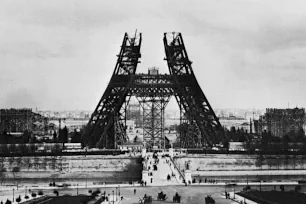
Construction started in January 1887 and the tower was completed just two years later, on March 31, 1889, in time for the opening of the World Exhibition on May 5 that same year.
Some 18,000 metal pieces were prefabricated in Eiffel’s factory on the outskirts of Paris. The components were partly pre-assembled and then assembled on site with rivets – 2.5 million in total – that were heated to ensure a tight fit. Caissons were built to create the concrete foundation below the water level of the nearby Seine River, and wooden scaffolds and small steam cranes allowed the workers to construct the metal tower.
After the World Exhibition
Initially, the plan was to demolish the tower twenty years after the end of the exhibition. But Eiffel, knowing his tower would eventually become under threat, promoted the tower for scientific use even before construction had started. And with success: The tower was used as a sort of laboratory by plenty of scientists and instruments such as barometers, anemometers and gravity instruments were installed inside the tower.
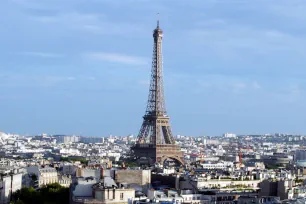
But it was its use as a wireless transmitter that eventually saved the Eiffel Tower from demolition. The tower was first used as a telegraphy transmitter in 1898 and in 1903 an experimental wireless transmitter was installed for military purposes. Six years later, a permanent underground radio center was built near the south pillar of the tower. In 1957 a television antenna was added to the top of the tower. The Eiffel Tower is still in use as a radio and television tower to this day.
Controversy
During construction there was a lot of controversy about the tower and some of the most famous names in contemporary literature and arts protested against what they considered a blight on the city. They feared the construction would be the advent of structures without “individuality” that did not fit into the established Parisian architecture.
The Tower Today
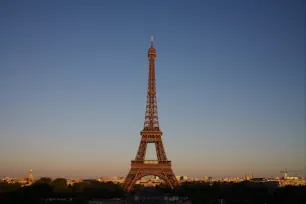
Today, there is no such aversion anymore among Parisians, on the contrary: one could not imagine Paris without the Eiffel Tower; in fact, it has become the symbol of the City of Light.
Its height
The official height of the Eiffel Tower has changed over the years due to the addition of antennae for wireless transmissions. When it was inaugurated in 1889 the tower, including its flagpole, measured exactly 312 meters or 1024 feet. Its height first increased in 1957 with the addition of a broadcast antenna, and further updates to the antennae took place in 1991, 1994, and 2000. The latest increase occurred in 2022 with the addition of a digital antenna which increased its height to 330 meters or 1083 feet.
The color
The tower was originally painted in a reddish brown color using 60 tonnes of paint. The paint was necessary to protect the iron tower against rust and pollution. This is why the tower gets repainted every seven years, as recommended by Eiffel himself.
Just like its height, the color of the Eiffel Tower has changed over the years. In 1892 the tower was painted ocher; seven years later it was painted yellow-orange, followed by yellow-brown in 1907 and brownish-red in 1954. In 1968 the color was changed to the iconic bronze tint that is known as “Eiffel Tower brown”, which was chosen for its harmony with the Parisian landscape. It is applied in three shades: dark at the bottom and lighter towards the top.
In 2018 the project to repaint the Eiffel Tower for the twentieth time was started. It consisted of the removal of the existing layers of paint and replacing them with a new ‘gold’ hue in celebration of the 2024 Paris Olympic Games.
The lights
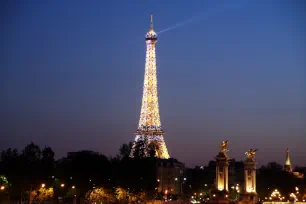
The Eiffel Tower is at its most spectacular at night, when it is illuminated with a sparkling display of golden LED lights. There is also a beacon at the top that sends out two blue light beams.
There have been lighting installations on the Eiffel Tower ever since its inauguration, when 10,000 gas lamps were installed on the tower. Over the years, temporary lighting displays have been installed on the Eiffel Tower to celebrate various events such as the new millennium and Europe Day. The current nightly display of numerous sparkling lights started in 2003, after the success it received during the millennium celebrations.
Copycats
The iconic design of the Eiffel Tower has been copied numerous times, albeit never with the same success or grace as the original. Today, more than sixty of these towers can be found all around the world. Some, like the 333-meter-tall (1,092 ft) Tokyo Tower from 1958 were only inspired by the Eiffel Tower, while others, like the 1:2 scale tower in Las Vegas, are replicas. Some other notable replicas include two 1:3 scale towers in China; one in Shenzhen and another one near Hangzhou. There are also two 1:4 scale replicas in Pakistan: one in Lahore and another one in Karachi. There’s even a copycat in France: the small town of Chambretaud in western France has its own replica in scale 1:10 which was given the name «Eyffela».
Visiting the Eiffel Tower
Getting there
Unfortunately, there is no metro stop right near the Eiffel Tower. The easiest way to get there is by taking metro line M8 and exiting the metro station École Militaire, which is near the southeast corner of the Champ de Mars, the park in which the Eiffel Tower is located. From there it’s a short walk to the Champ de Mars and about a ten-minute walk to the tower. A bit closer by but without the great views you’ll get by walking through the park is the metro station Bir-Hakeim (M6), situated east of the Eiffel Tower near the Seine River.
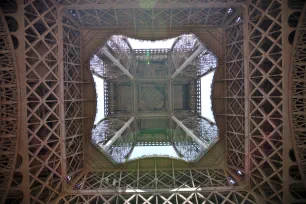
You can walk up to the esplanade under the Eiffel Tower, although it is not as easy or pleasant as it used to be. In 2018 the area was cordoned off by glass panels, and you now have to pass a security check first before you can access the esplanade and surrounding gardens. Visiting this area is free, you only need to buy a ticket if you visit the tower itself.
Visiting the tower
The Eiffel Tower features three floors. The main attraction of the first floor, situated at a height of 57 meters (187 feet), is its glass floor. There are also restaurants and shops. You can access this floor either by climbing about 300 steps or by taking the elevator.
The second floor, at a height of 115 meters or 377 feet, offers amazing views over Paris. You can find more restaurants and shops on this floor. This floor is also accessible by means of an elevator or by climbing 674 steps (this takes about 30 minutes, but you can take a break on the first floor).
A glass-walled elevator from the second floor brings you to the third and top floor, situated at a height of 276 meters (906 feet). From here you have a wide view over the region. It features two levels, one outdoor and one indoor. But there’s more than just the view. You can also visit the restored office of Gustave Eiffel, who in his time – before the elevator was installed – had to climb 1665 steps to reach his office. Today, the staircase between the second floor and the top is closed off, so you have to take the elevator if you want to visit the top floor.
Best views of the Eiffel Tower
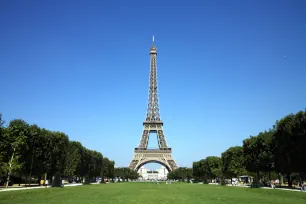
Due to its height, the Eiffel Tower is best viewed from a distance. Fortunately, there are some easily accessible sites in Paris from which you have a great, unobstructed view of this engineering marvel:
- Esplanade du Trocadéro: Across the Seine River, atop a hill, sits the Chaillot Palace. Between the two wings of the palace is a wide esplanade that, thanks to its elevation, offers unobstructed views of the Eiffel Tower.
- Champ de Mars: The Eiffel Tower is located on the northern border of a park known as the Champ de Mars. From the other (southern) side of the park, you also have an unobstructed view of the tower.
- Tour Montparnasse: For a totally different vantage point, visit the observatory of the Tour Montparnasse, the only skyscraper in the vicinity of the Eiffel Tower. From its 56th floor, you not only have a great 360 degree view over Paris, but you also get to see the Eiffel Tower from a different angle.
- Arc de Triomphe: You can also get a good view from the top of the Arc de Triomphe. Here you can see just how much the Eiffel Tower rises above the dense Parisian apartment blocks.
